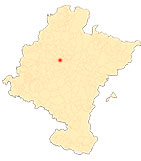The chapel of San Fermín
A recovered green man
The arch recovered in 2008 can be found at sample , which is covered by a brick wall, and on it we can see the mark of an old solid circular oculus and perhaps also the imprint of a previous rectangular window (remember that oculi were common in the building during the renovation by Ochandátegui from 1800 to 1805). The importance of the finding lies in the plastic motif that exhibits the core topic of the arch as ornament: nothing else than the representation of a green man, topic well known and widely spread in time, geography and cultures; and which consists in the representation of a human face by means of the employment combined of real vegetal and anatomical elements. The sculpted subject is a limestone of easy workmanship, of whitish tonality, well differentiated in chromatic tone from the neighboring grayish voussoirs. It seems that each and every one of the exterior arches of the chapel had its corresponding green man, sculpted in the respective core topic. In fact, today we can see the employment of the same whitish stone for all the central voussoirs. Undoubtedly, for Ochandátegui's architectural statement of core values it was essential to purify the arcades of anecdotal elements of baroque lineage, dispensing with masks that were felt to be caricatures. To this end, the keystones were chiseled, which made it possible to match their surface with the smooth course of the threads without further complication. In the Calle Mayor of Pamplona, between 1709 and 1716 the work on the façade of the palace of the Marquises of San Miguel de Aguayo, until recently known as high school de Teresianas, a building very close to the Chapel of San Fermín, inaugurated in 1717, was completed. Precisely on the lintel of this palatial doorway there is a representation of a green man. The proximity of both constructions and their coincidence in time lead us to think that the repetition of the same plastic motif is not merely coincidental.
-
ANÓNIMO, Relación de las Plausibles Fiestas con que ha celebrado la Mui Noble i Mui Leal Ciudad de Pamplona, Cabeza del Ilmo. y Fidelissimo Reyno de Navarra, la Translación de su Gran patron saint San Fermín de la Antigua Capilla a la Nueva, que ha fabricado su devoción, Pamplona, Juan José Ezquerro, 1717.
-
GARCÍA GAINZA, M. C. and others, Catalog Monumental de Navarra, t. V***, Merindad de Pamplona. Pamplona. Indices generales, Pamplona, Government of Navarra, Archbishopric of Pamplona, University of Navarra, 1997, pp. 187-196.
-
MOLINS MUGUETA, J. L., Capilla de San Fermín en la iglesia de San Lorenzo de Pamplona, Pamplona, Diputación Foral de Navarra-Institución "Príncipe de Viana",Ayuntamiento de Pamplona, 1974.
-
MOLINS MUGUETA, J. L., El culto a San Fermín, in "Sanfermines. 204 horas de historia", Pamplona, Larrión y Pimoulier, 1992, pp. 31-39.
-
MOLINS MUGUETA, J. L., Las Capillas de San Fermín y Ntra. Sra. del Camino en Pamplona, in "El Arte en Navarra", no. 27, Pamplona , Diario de Navarra, 1995 , pp. 417-432.
-
On the website of the Chair de Patrimonio y Arte Navarro: An example of a "green man" in the Chapel of San Fermín in Pamplona, in "La pieza del mes", December 2013.












